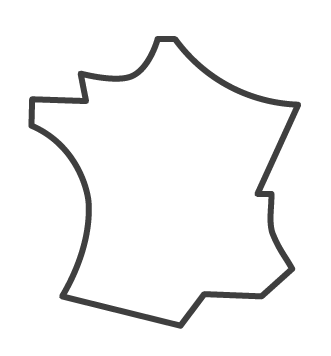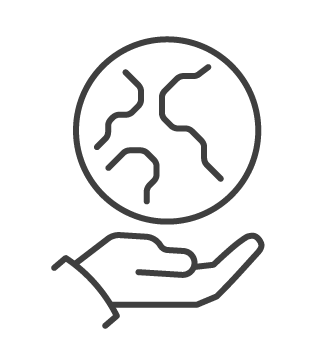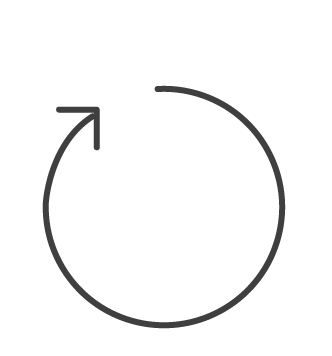Our latest innovation: M_MAT_mycelium
Today we unveil the M_MAT_mycelium, our new alternative to leather, powered by MycaNova-Citribel.
This brand-new material, which will adorn our upcoming products, is the result of our 18-month collaboration with the MycaNova team, full of long discussions, hopeful try-outs, epic failures, and many lessons learnt.
This new alternative to leather meets our demanding requirements in both performance and aesthetics, and allows us to continue to lower the impact of our products on the environment.
So, what is Mycelium exactly and why does it matter?
Mycelium or mushroom? These 2 terms are often used to designate the same thing. There are indeed related as both refer to different stages of fungus lifecycle.
Mycelium is a network of interwoven filaments called “hyphae” and is abundantly found in the superficial layer of soil or directly visible on the ground of our forest. Mycelium can be seen as the “roots” of fungus, if we try to simplify it.
So, what about mushrooms then? If mycelium is the “roots", then they would be the “fruit” of mycelium, the visible part that will bloom at the surface.
Mycelium is critical for the ecosystems where it lives, especially because of its role in decomposing organic elements fallen on the ground, like branches or tree trunks. As it grows and decomposes organic matter, it contributes to feeding the entire surrounding ecosystem.

But if the world is talking more and more about mycelium, it is because of the tremendous potential it could represent for human beings, with many different fields of application. For instance, studies have shown that certain mycelium strains can decompose plastic materials, leaving nothing but biodegradable residue with no trace of pollution agents.
Medicines, materials, biofuels, … the potential of mycelium, a durable and ecological natural resource, seems incredibly large for our society. And we are just beginning to explore it…
Why did we choose MycaNova?
There are many strains of fungus, meaning many different types of mycelium and mushrooms, and each seems to have different capabilities and potential.
However, all these strains have in common to require very specific conditions of temperature, humidity and lighting to grow correctly.
To develop the M_MAT_mycelium, we were looking for a European partner, especially to facilitate the discussions and to limit the impact of transport on our operations. But what we found with MycaNova exceeded by far the sole geographical criterium.
Because behind MycaNova, a young company developing materials for fashion, there is a century-old Belgian company called Citribel which holds a unique industrial know-how.
Citribel is a world leading company in the production of citric acid. But opposite to many players of its industry, Citribel has developed a virtuous circular technique to produce its citric acid, with mycelium as a wonderful side effect.
To produce citric acid, Citribel relies on sugar molasses, an abundant coproduct of sugar refineries, especially those located in the region. The sugar contained in the molasses will serve as the ideal nourishment for a specific fungal strain that has been carefully looked after by Citribel for decades. Placed in optimal conditions of temperature and humidity, the fungus spores will consume sugar and grow into mycelium, generating citric acid as a side product.

Through this circular fermentation process, Citribel produces the equivalent of six football fields per day of mycelium. This abundant yet undervalued co-product has now become the main ingredient for MycaNova to develop its innovative materials.
Citribel has also been investing for years now to reduce its impact on the environment. Since 2021, a cogeneration plant, which produces energy and steam by recycling the heat used in the fermentation and refinery processes, allows Citribel to significantly reduce its need of external energy.
The mycelium collected every day by Citribel is later dried and transformed into dry mycelium powder. Subsequent operations take place in Italy, near Milan, where MycaNova has gathered its team of experts in textiles materials and has established a unit for developing and producing its materials.

Our M_MAT_mycelium material at a glance
M_MAT_mycelium is the result of our collaboration with the MycaNova team to improve the performance of an already-existing reference of their innovative material.
Like any efficient alternative to leather on the market, our material is primarily made of a textile “backing”, which will give the finished material most of its physical performance as well as contribute to its tactile experience.
To allow us to stick as much as possible to traditional leather techniques, we have chosen a backing layer made of recycled nylon microfiber, sourced directly from a leading company in the textile industry. This material offers the optimal performance and durability we are looking for, while allowing our artisans to apply their incredible techniques and savoir-faire.
The backing fabric is then covered with a “coating”. This layer is formed by a resin which mixes the dry mycelium powder and binders made of bio-polyurethane (bio-PU). This resin is laid onto the backing to form the finished material.
By inserting pigments in the resin formulation prior to the coating phase, we can customize the finished materials and obtain very precise colours, specific to Maison Maes. And when applying the coating to the backing, we can also adjust the level of shine and the pattern (like the fine leather grain we are currently using).
Since we are talking about bio-PU, it is very important to do so with maximum caution and to be as precise as possible. Because behind the term “bio-PU” often hide very different truths. Bio-PU is polyurethane (e.g. plastic) where fundamental elements (mostly polyols) have been replaced with bio-based components, coming most of the time from non-edible by-products of the food industry (like sugarcane waste or castor oil). There is no industrially viable 100% bio-based PU available as of today, and “Bio-PU” is often wrongfully used to designate plastics where the percentage of bio-based components is very poor. For what matters, the Bio-PU used in our M_MAT_mycelium contains 60% of bio-based components.
If our ultimate goal is to reach 100% of bio-based components as soon as possible, we are still happy and proud. In its current version, the M_MAT_mycelium allows us to reduce further by 13% the carbon footprint of our handbags compared to our other materials, and close to -70% compared to a theoretical average handbag of similar size.
The last 18 months developing this new M_MAT_mycelium and working on our new colours have been an extraordinary adventure. We are proud that the first Maison Maes products made with this material are now available and for that, we want to thank once again the MycaNova team for their incredible work and continued support.

![Sac à main M1_06 noir vu de profil - MAES Paris, Haute Maroquinerie innovante & responsable [color:kaki,khaki]](http://www.maesparis.com/cdn/shop/files/maison-maes-m1_06-kaki-sac-a-main-cuir-vegetal--2-profil_29cff34d-01ae-4a19-b6d3-04c6c95c20d2_{width}x.jpg?v=1709313336)
![Sac à main M1_06 kaki vu de face - MAES Paris, Haute Maroquinerie innovante & responsable [color:kaki,khaki]](http://www.maesparis.com/cdn/shop/files/maison-maes-m1_06-kaki-sac-a-main-cuir-vegetal--1-face_2f940fd1-72c4-4f83-a2d7-b1aaffec94ef_{width}x.jpg?v=1709313336)
![Pochette avec chaine M1_02 en M_MAT_cactus noir vue de profil - MAES Paris, Haute Maroquinerie innovante & responsable [color:noir,black]](http://www.maesparis.com/cdn/shop/files/maison-maes-m1_02-noir-sac-a-main-cuir-vegetal--2-profil_{width}x.jpg?v=1709650772)
![Pochette avec chaine M1_02 en M_MAT_cactus noir vue de face - MAES Paris, Haute Maroquinerie innovante & responsable [color:noir,black]](http://www.maesparis.com/cdn/shop/files/maison-maes-m1_02-noir-sac-a-main-cuir-vegetal--1-face_{width}x.jpg?v=1709650772)
![Sac à main M1_01 carmin vu de profil - MAES Paris, Haute Maroquinerie innovante & responsable [color:carmin,carmine]](http://www.maesparis.com/cdn/shop/files/maison-maes-m1_01-carmin-sac-a-main-cuir-vegetal--2-profil_{width}x.jpg?v=1709313189)
![Sac à main M1_01 carmin vu de face - MAES Paris, Haute Maroquinerie innovante & responsable [color:carmin,carmine]](http://www.maesparis.com/cdn/shop/files/maison-maes-m1_01-carmin-sac-a-main-cuir-vegetal--1-face_{width}x.jpg?v=1709313189)
![Sac à main M1_03 camel vu de profil - MAES Paris, Haute Maroquinerie innovante & responsable [color:camel]](http://www.maesparis.com/cdn/shop/files/maison-maes-m1_03-camel-sac-a-main-cuir-vegetal--1-profil_{width}x.jpg?v=1684251847)
![Sac à main M1_03 camel vu de face - MAES Paris, Haute Maroquinerie innovante & responsable [color:camel]](http://www.maesparis.com/cdn/shop/files/maison-maes-m1_03-camel-sac-a-main-cuir-vegetal--1-face_{width}x.jpg?v=1684251847)
![Pochette M1_04 bleu nuit vue de profil - MAES Paris, Haute Maroquinerie innovante & responsable [color:bleu nuit,night blue]](http://www.maesparis.com/cdn/shop/files/maison-maes-m1_04-bleu-nuit-pochette-cuir-vegetal--2-profil_{width}x.jpg?v=1684252706)
![Pochette M1_04 bleu nuit vue de face - MAES Paris, Haute Maroquinerie innovante & responsable [color:bleu nuit,night blue]](http://www.maesparis.com/cdn/shop/files/maison-maes-m1_04-bleu-nuit-pochette-cuir-vegetal--1-face_{width}x.jpg?v=1684252706)
![Porte-cartes M1_05 camel vu de profil - MAES Paris, Haute Maroquinerie innovante & responsable [color:camel]](http://www.maesparis.com/cdn/shop/files/maison-maes-m1_05-camel-porte-cartes-cuir-vegetal--2-profil_{width}x.jpg?v=1684253446)
![Porte-cartes M1_05 camel vu de face - MAES Paris, Haute Maroquinerie innovante & responsable [color:camel]](http://www.maesparis.com/cdn/shop/files/maison-maes-m1_05-camel-porte-cartes-cuir-vegetal--1-face_{width}x.jpg?v=1684253446)


